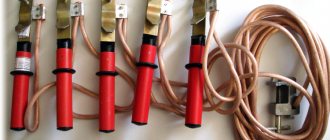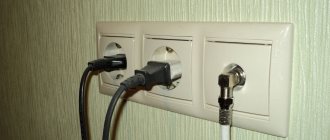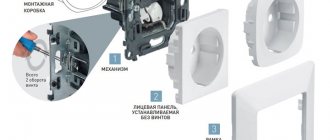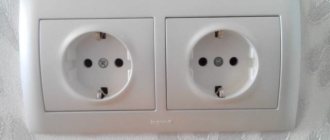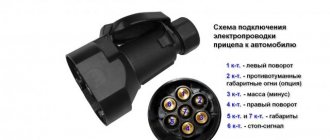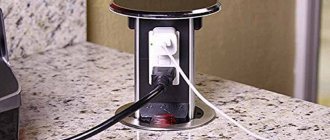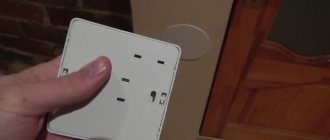Replacing the old switch
The simplest job is to replace the old switch with a new one. It includes two operations - dismantling the old device and installing and connecting a new device. The order in which they are carried out depends on the type of device.
How to remove the old switch
The work is carried out in this order:
- Use a flathead screwdriver or knife to separate the key. Some models have an additional strap for pressing it, which must first be removed.
- The switch cover is removed by unscrewing the screw (sometimes two screws).
- The screws of the fastening tabs that secure the switch in the socket are loosened.
- The entire switch is removed from the socket.
- The supply wires are removed from the terminal clamps.
A two-key switch is removed in the same way as a single-key device is removed.
Some apartments still have old type switches. They have an outdated design, and the dismantling procedure is slightly different. In them the key cannot be removed, because The device cannot be disassembled.
Two screws are unscrewed (sometimes one, in the center), and the cover is removed. Next, loosen the screws of the mounting tabs and remove the switch. The ends of the wires are most often secured with screws. They are unscrewed with a flat screwdriver and the wires are released.
Installing a new switch
Work is carried out in reverse order:
The ends of the wires are inserted into the holes of the terminal clamps and securely secured with screws
In two-gang switches, the markings applied during dismantling are taken into account. In single-key designs, the order in which the wires are connected does not matter. The switch is inserted as far as possible into the socket and aligned
Excess wires are carefully laid out in the socket. Fixation is ensured by two screws, with the help of which the body is wedged with side legs. Install the decorative cover using one or two screws. Pressing lightly with your hand, set the keys until a characteristic click appears.
After checking the operation of the mechanism, you can connect the electricity. Some modern switches may have an original design. The installation procedure is described in the instructions for the device.
Wire extension
The essence of this method is that in order to move the outlet in the apartment yourself, you may need to extend it. Of course, in this case, it may be necessary to chip the wall, but this option is considered more attractive than the first.
The laying technology will look like this:
- Turn off the circuit breaker that will lead to the outlets.
- Now check the device for current.
- Remove the decorative cover of the device and remove the socket.
- Now you need to lengthen the line. You can see ways to connect wires in our article.
- In place of the old groove, install a socket box and lay the wires in it.
- Now install the socket and connect the wires.
This is how you can simply transfer a power outlet with grooves to another wall or to the floor. If you are planning to extend your conductor, then remember that you should use a cable of the same cross-section. If you do not know what cross-section the cable has, then you should calculate the cross-section.
You may also encounter a situation where the sockets need to be moved closer to the distribution box and the wire will need to be shortened rather than extended. In this case, you will need to create a new groove, shorten the line and install a new product.
Many people make a mistake when using this method. The main mistake is that they connect an extended wire by placing it in an old socket box groove and covering it with alabaster. You should not do this, since in this case access to all connections will simply be denied.
Moving a socket by extending the wire
In an effort to simplify the work of moving an outlet, a method is often used in which the wire is extended to the required length, and the “glass” of the old outlet is used as an auxiliary distribution box.
When moving the “point” by extending the conductor, the mounting “glass” of the old socket acts as a distribution box for connecting wires
Aluminum wiring is used in older houses. But modern requirements dictate the laying of cables with a cross-section of 1.5 mm2 with copper conductors, including grounding.
Extension of the electric line in a new groove cannot be carried out without partial destruction of the wall. But even under this condition, this option for moving the socket is more preferable than the daisy chain method.
Complete replacement of wiring is a rather expensive procedure, which is best planned during a major overhaul.
Sequence of actions when extending the wire:
- Disconnect the socket group from the network by turning off the circuit breaker on the apartment panel.
- Using an indicator screwdriver, check the absence of current in the terminals.
- The decorative cover is removed from the old socket, and the body is pulled out of the groove.
- Using a simple pencil, mark the line for laying the grooves.
- A groove is made along the intended line using a hammer drill or grinder.
- Using a crown, a hole is drilled out for installing a socket box.
- By connecting wires, the line is extended.
- In place of the old mounting block, a distribution box is installed, into the cavity of which the places of fastened conductors are placed.
- A socket box is installed in the hole made.
- The free ends of the extended wire are connected to the terminals of the socket block.
- The connected socket block is buried in the “glass”.
- A decorative panel is mounted on the installed socket.
When using an old socket box as a distribution box for extending wires, avoid contact of the connection with the putty material.
For this purpose, some craftsmen cut a plasterboard overlay to the size of the “glass”. First, it is attached to the front edge of the socket box using liquid nails, and then a liquid layer of putty solution is applied on top.
Wire connections made by twisting the ends must be insulated using heat-shrink tubing or by wrapping 2-3 layers of electrical tape
The main mistake that novice craftsmen make is when the “extended” conductor is placed back into the old groove, and then covered with gypsum mortar or alabaster. But by blocking access to connections, they do not take into account that if a section of the network breaks down and becomes inoperable, it will not be possible to quickly correct the situation.
If a situation arises when the connection point needs to be moved closer to the junction box, the work is even easier. After all, the wire will only have to be shortened. To do this, a hole is made in the wall for installation of the mounting block. Using a knife, shorten the previously laid line. Installation of the product is carried out in accordance with the recommendations described above.
Preparatory work
In preparation, first of all, a diagram is drawn up, the location of sockets or switches is selected, and the location of the cable is determined. To do this, you need to find out how hidden wiring is laid. If it was made according to standard projects, then you can find the wires using a special device. Then the amount of work is assessed, and the necessary tool is selected if the work is done by hand:
- perforator;
- screwdriver, pliers, hammer, chisel, probe.
The following materials are needed:
- mounting box;
- cable (recommended VVGng);
- socket;
- dowel-clamp, plaster or alabaster, electrical tape.
When choosing an outlet, you need to correctly determine which type is needed. Currently, grounded sockets are used. When moving them, provision should be made for laying a grounding wire.
Safety standards come first
Before you start moving sockets in your apartment, you should definitely familiarize yourself with the following safety standards.
Before starting work, you will need a wiring diagram for the apartment. If there is none, then you can find the old wiring using a non-contact indicator. This procedure is required to dismantle old wires and install new ones carefully, without damage.
Be sure to turn off the machines in the panel located at the entrance to the apartment, breaking the connection of both the “zero” and the “phase”. If only one wire is disconnected, then use an indicator screwdriver or multimeter to make sure that no current is being supplied.
If complete de-energization of the wiring is not possible, it is imperative to use dielectric gloves for any action and exercise extreme caution to avoid short circuits. In the absence of lighting, a battery-powered flashlight is used.
It is permissible to move the socket with your own hands using a cable with a cross-section of at least 1.5 square meters. mm.
The cable can only be laid vertically and horizontally. If the installation is horizontal, the distance from the ceiling should not be less than 20 cm, and not less than 10 cm from the cornices and beams. If the installation is vertical, the distance from corners, as well as windows and doors, is at least 10 cm.
Sockets are placed at a distance of 0.5-0.8 m from the floor, and 0.5 m from heating radiators, steel pipes and gas appliances.
Connections of cable branches must be made in special housings - boxes. Terminals (clamps) are used for any connections—tightening the wires just like that is strictly prohibited.
A new socket is mounted from 80 cm to one meter, sometimes up to one and a half meters.
Connection options
If a wire needs to be extended, there are several ways to connect it to another wire. The choice of a specific option depends on the material from which the cores are made, as well as their cross-section and the number of conductors.
Connection with adapter screw terminals
This method is one of the most reliable and has been used for many decades when organizing lines even at industrial facilities. Adapter terminal blocks can be used in two versions, one of which involves the presence of spring terminal blocks, and the other - terminal blocks.
There are numerous terminal block models on the market. Often you come across low-quality products
Therefore, when purchasing, you should pay attention to the quality of the product, its ability to firmly press the cable and withstand mechanical pressure when tightening the screws tightly
There are disposable pads on sale (they cannot be repaired) and reusable spring plugs (the contact can be disconnected multiple times). It is recommended to select the pads based on the diameter of the inlet hole being the same as the cross-section of the cores. Unlike spring terminals, it is not advisable to use terminal blocks to connect aluminum wires, since this metal is very fragile and can be deformed during tightening.
Stranding with welding
This method of connecting wires was previously used everywhere, including when working with aluminum wiring. At the moment, twisting with welding is also used, but is no longer so relevant, since simpler methods have appeared. The main disadvantage of this technique is the need for special equipment and an experienced welder.
Fixation with plastic caps
In this case, the wiring connection is made through the use of PPE (connecting insulating clamps). Plastic caps are made of fireproof material, which prevents fire due to a short circuit in the area where the cores are connected.
The caps are convenient to use. They are made in different colors for zero, phase and ground.
The only drawback of the caps is the large number of fakes when the product is equipped with a weak internal spring.
Stranding with soldering
Connecting electrical wiring using soldering is considered the highest quality option. However, to perform such work, the ability to use a soldering iron is required. If you follow all the technological nuances, the twist will retain its performance characteristics for decades.
Instructions for creating a twist with soldering:
Strip the ends of the cable to ensure the required contact area of the side surfaces. It is necessary to leave only the pure metal from which the cores are made. The length of the area to be cleared is 8-10 centimeters. Grasp the wire with pliers on both sides and create a tight twist
It is important not to overdo it when tightening the wires, as the wire may break. Solder the twisted wires with solder and rosin. Important note: acid fluxes are unacceptable, as they will cause metal corrosion in the future.
Wago terminal blocks
The design of these terminal blocks makes it possible to carry out electrical installation work efficiently and as quickly as possible. The quality of contact is ensured by an internal spring system. Wago terminal blocks have received a European quality certificate and are the preferred method of connecting wires among foreign electricians.
Wago terminal blocks do their job well during network overloads. However, these devices also have a drawback: the contact area does not allow for good heat transfer, removing energy through their design. As a result, if the loads are higher than permissible, heat is transferred to the wires, and this leads to fire of the insulation. Thus, the use of Wago terminal blocks is only permissible in combination with a machine that avoids overloads in the local network.
Why move the switch?
In real conditions, the need to move a light switch indoors may arise for various reasons:
- Inconvenient height position. The switch is too high for small children to reach. Or, on the contrary, the children have already grown up, and he is too low - he has to bend down.
- Access limitation. For example, he ended up behind a cabinet or bar counter.
- The desire to rearrange the furniture, and the switch turns out to be closed.
- Increased convenience. Ensuring that the light is turned on from another room or from several places, bringing the switch closer to the bed or chair, etc.
- Consequences of repair. A good reason is to combine several rooms. Moving, for example, the kitchen into the living room, dividing a large room into several rooms, reinstalling the front door, etc.
Perhaps the opportunity has arisen to install a new structure, but it does not fit in its original place.
COST OF INSTALLING SOCKETS
| NAME OF WORKS | COST, RUB.) |
| Installation of the point including the hole and installation of the socket box in concrete | 900 |
| Installation of the point including the hole and installation of the socket box in the monolith | 900 |
| Installation of the point including the hole and installation of the socket box in the brick | 650 |
| Replacing an old electrical point | 450 |
| Installation of an external electrical point | 400 |
| Installation of a surface-mounted socket (five-pole) | 550 |
| Installation of a socket box | 100 |
| Installation of a telephone socket | 300 |
| Installation of circuit breaker (single-pole) | 500 |
| Installation of a circuit breaker (three-pole) | 1000 |
| RCD installation | 800 |
| Installation of a two-pole RCD | 1000 |
| Transformer installation | 500 |
| Setting a call with a button | 900 |
| Installing a computer network outlet | 700 |
| Installation of an overhead distribution panel | 3200 |
| Installation of an overhead distribution panel for 12 machines | 5300 |
| Installation of an overhead distribution panel for 18 machines | 7000 |
| Installation of an overhead distribution panel for 24 machines | 9000 |
We work in Moscow and Moscow Region (Khimki, Kurkino, Skhodnya, Dolgoprudny, Lobnya, Mytishchi, Bolshevo, Korolev, Yubileiny, Pushkino, Shchelkovo, Balashikha, Reutov, Zheleznodorozhny, Lyubertsy, Dzerzhinsky, Kotelniki, Vidnoye, Shcherbinka, Klimovsk, Chekhov, Podolsk, Odintsovo, Krasnogorsk, Nakhabino, Mitino, etc.)
Order electrician services
We provide a guarantee of 12 to 36 months for all types of electrical installation work!
METHODS OF INSTALLING SOCKETS
8(495)509-53-15
One of the most common ways in which sockets are installed is in a cable channel. Such installation, subject to the availability of a spare cable, allows you to move along the channel, taking into account the arrangement of furniture and interior items. Another advantage of this installation is the possibility of installing additional sockets in the future in the same cable channel.
External installation of sockets is carried out on open electrical wiring, so this installation is most suitable for the street or country house. Hidden installation of sockets is carried out in the wall, in special socket boxes. This option is ideal for premises: apartments, offices, etc.
Replacing or installing sockets takes place in several stages:
Drilling the wall to install a socket for a socket box (for an internal socket)
Installation of a socket box (for an internal socket)
Connecting electrical wires to the socket mechanism
Installing the cover (decorative trim) of the outlet
Checking the functionality of the outlet
Installing sockets with us is a guarantee of quality and reliability!
Useful tips
When carrying out electrical installation work, special attention should be paid to the following nuances:
All wiring operations are performed only when the line is de-energized. Since the use of electric tools is necessary, it is better to provide for them a temporary input with a separate automatic machine. To make sure there is no current, it is recommended to check the wiring with a probe. Before moving the outlet to another location, you should determine the location of the old lines so as not to damage the wires when cutting channels. In panel buildings, gating of load-bearing structures is not permitted. In reality, this rule is often violated
If such work is nevertheless carried out, it is very important to prevent damage to the reinforcement in the slabs. It is better to avoid gating altogether and give preference to laying wires under screed, plaster or plasterboard sheets. When the wires are inserted into the junction box, you need to take into account the installation margin of 10-15 centimeters
If you ignore this issue, in the future (if changes in the wiring are necessary) you will need to build up even high-quality wire, and this will again force you to gut the wall. Do not create direct contacts between copper and aluminum wires.
If you follow these simple rules, it is quite possible to move the socket with your own hands.
It is important not to forget about safety measures and try to do the work as efficiently as possible, because not only the comfort, but also the safety of the residents depends on this
Reasons for moving the outlet
The most common reasons for which there is a need to move an outlet are:
- Rearranging furniture or installing new equipment - in the first case, moving the connection point is determined by the fact that access to the old ones is closed, in the second, by the inability to make electrical contact at this point.
- Excessive heating due to a large number of connected consumers at one electrical point. Since this can lead to overheating and further fire.
- Due to lack of voltage or malfunction of the old device, which does not allow replacing them with new ones.
Which wire is better to use
The VVG wire or its flat modification VVG-Png is like no other suitable for laying hidden electrical networks. True, it is a little more difficult to work with a monolithic conductor than with a stranded one, but this disadvantage, if it can be called a disadvantage, is compensated by the reliability and long service life of the walled wire. An article dedicated to this topic will help you choose the right parameters of the electrical wire for its use in the apartment. In principle, there is a choice. If the groove path is replete with bends and differences in planes, then only NYM. This wire is good for everyone, but expensive. It costs almost twice as much as VVG. It is for hidden wiring that VVG-Png is most often used. True, working with this wire is not easy, but if the cross-section is chosen correctly, the result is guaranteed to be reliable. As a last resort, to slightly extend the line, you can use PUNP.
Connection diagrams
There are two known schemes of varying complexity that allow you to move the socket to a new location without destroying the finishing material of the walls:
- By forming a kind of loop, in which wires are laid from the previous installation location to a new point by simply building up the phase and ground busbars.
- Laying a completely updated line starting from a linear machine and ending in the desired wall area in the kitchen, for example.
The first of these techniques is used when the new installation point is slightly removed from the old location, and the second - if the distance exceeds 5-7 meters.
The second installation option will require major work related to the preparation of the layout of the future route, as well as the selection of the type of wire and method of its wiring. But in this case, it is possible to do without an unwanted intermediate connection, which can degrade the performance of the entire power supply system. If an extension scheme is nevertheless chosen, the following important points must be taken into account:
- To implement this option, it is best to use wires made of the same material and with the same core cross-section as the original cable connected to the old location. This will improve the quality of connections and eliminate the need for special terminal blocks.
- The reliability of a loop of several parallel-connected sockets is very low compared to laying a new line.
- An accidental break at the very beginning will lead to de-energization of the entire chain of sockets connected to it.
When choosing an extension cord connection diagram for a new socket(s), you should proceed from the specific operating conditions of the household equipment and the quality of the wall surfaces. Taking these factors into account allows you to successfully cope with the task and eliminate problems that often arise in electrical circuits.
Relocation of sockets in St. Petersburg - price from 250 rubles. | GSK
Relocating sockets is a service that is sought after not only by residents of older buildings. Even when moving into a new building or when remodeling a premises (residential or office), the installation of several additional points for connecting electrical appliances is required.
If necessary, the transfer of sockets and switches is carried out simultaneously with the installation of wiring. But the problem can be solved with minimal damage - in this case, the line for connecting to the electrical panel or junction box will be laid openly, in a corrugated pipe or plastic box.
How much does it cost to move sockets to St. Petersburg?
The cost of relocating outlets is usually low. The main parameters that affect the price will be:
- Number of new connection points requiring installation.
- Type of wiring (hidden or open).
- Wall material (the denser the material, the more difficult, and therefore more expensive, it will be to cut grooves for hidden installation).
Prices for operations to transfer and install switch sockets are given in the price list. The final amount is negotiated with the master after agreeing on all the details of the project.
Installation of sockets and switches
Name of workUnits unit Price/rub.
| Installation of a three-pole household socket open. | PC | 400 |
| Installation of a three-pole hidden household socket | PC | 600 |
| Circuit breaker installation | PC | 250 |
| Installation of circuit breaker (double pole) | PC | 300 |
| Installation of a circuit breaker (three-pole) | PC | 400 |
| Installing the socket/switch mechanism | PC | 250 |
| Installing a socket/switch mechanism (more than one in a frame) | PC | 300 |
| Switch connection | PC | 500 |
| Connecting a switch (two-key) | PC | 600 |
Installation, laying and pulling of cables and wires
Name of workUnits unit Price/rub.
| Installation of a three-wire power cable (cross-section 1.5 mm) | m.pog | 90 |
| Tightening a three-wire power cable (cross-section 1.5 mm) into a corrugation | m.pog | 110 |
| Installation of a three-wire power cable (cross-section 1.5 mm) in an open way | m.pog | 90 |
| Installation of a three-wire power cable (cross-section 2.5 mm) in a groove | m.pog | 90 |
| Tightening a three-wire power cable (cross-section 2.5 mm) into a corrugation | m.pog | 110 |
| Installation of a three-wire power cable (cross-section 2.5 mm) in a cable channel | m.pog | 110 |
| Installation of a three-wire power cable (cross-section 2.5 mm) in an open way | m.pog | 90 |
| Installation of a three-wire power cable (cross-section 4 mm; 6 mm; 10 mm) in a groove | m.pog | 90 |
| Tightening a three-wire power cable (cross-section 4 mm; 6 mm; 10 mm) into a corrugated | m.pog | 110 |
| Installation of a three-wire power cable (cross-section 4 mm; 6 mm; 10 mm) in a cable channel | m.pog | from 130 |
| Installation of a three-wire power cable (section 4 mm; 6 mm; 10 mm) in an open manner on brackets on concrete and brick | m.pog | from 130 |
| Installation of a three-wire power cable (cross-section 4 mm; 6 mm; 10 mm) in an open way on wood brackets | m.pog | from 120 |
| Installation of TF cable, TV cable, computer cable installation | m.pog | 60 |
| Connecting TV and TF lines in the switchboard | PC | from 600 |
| Temporary lighting device | m2 | from 400 |
| Connecting LED strip | m.pog | from 600 |
Transfer methods
There are several transfer methods; depending on the method of connection and installation, the following can be distinguished:
- Application of a loop. This method is the simplest: a jumper is laid from the old switching point to the new one. However, this method has disadvantages:
- the wire is laid horizontally, there is a risk of damage during further work on the wall;
- If the old one breaks, the new switch becomes inoperative.
Note! For the new switch to work correctly with this transfer method, it is necessary that the second, old switch be in ON mode all the time
- Wire extension. This method is more reliable, but it is more labor-intensive. To move the switch using this method, you need:
- dismantle the old device;
- check the wires for voltage;
- make a groove to the installation site;
- connect the wires;
- put a distribution box in place of the old one;
- lay the cable, assemble a new switch.
Important! In old houses, aluminum wires are often found; in order to avoid incorrect operation and short circuits, there is no need to connect a copper wire to them. You will either have to change all the wiring or install the same aluminum wire
- Output of a new line. This connection method is the most reliable. The process is similar to extending a wire, only the starting point will not be the old switch, but the junction box. You also need to make a groove in the wall, run and connect the wire to the switch, and connect the wires in the box.
- It happens that you need to move a switch without damaging the wall. The transfer process will take place as described above, but instead of a groove, the wire is laid in a cable channel or plinth, where there are holes for wiring. You will also need to purchase a surface-mounted switch (a built-in switch will not work).
Any unfamiliar work seems difficult at first, but if you carefully study the sequence of actions, prepare theoretically and practically, and study safety precautions, even a person without special skills can handle electrical installation work.
Moving sockets and switches
—Good to know—Moving sockets and switches
You can order a service for moving sockets and switches by calling:
+7 or 213-7-380
Cost of services for moving sockets:
- The minimum cost of moving sockets in the kitchen is 1,500 rubles
- The average cost of moving sockets in the kitchen is 4,000 rubles
You can find out the cost of work on your site and call a surveyor for an accurate assessment of the scope of work by calling:
+7 or 213-7-380
Moving sockets and switches in the apartment with your own hands
The Stroy-M company offers its services for moving sockets and switches in apartments and other premises in a modern, high-tech way, using dust collection equipment and diamond technology. Fast, high quality, reliable, durable and most importantly safe! How to move the outlet to the place where it is needed? There are several ways to move sockets and switches:
Method No. 1, “Correct - costly”
The most expensive, but at the same time the most compliant with the requirements of PUE, SNiP and other regulatory documentation. So, imagine the existing outlet in your room, which is located in the place where the wardrobe is. The task is to transfer this
the outlet is two meters to the right and half a meter lower. In order to do everything correctly, you need to find a distribution box in the room from which this outlet is powered; as a rule, these boxes are located above the outlets, about two hundred millimeters from the ceiling. The box is opened, the twists in the box are de-insulated, untwisted, then a cable is added that will go to the new location for installing the socket. In order to hide the new cable in the wall, you need to raft (punch a groove in the wall) the wall. According to building codes, the fine must run strictly horizontally and vertically, i.e.
horizontally the groove should go at the level of the distribution box, in this case 200 millimeters from the ceiling, and above the place where the socket should be located, the groove should be turned at an angle of 90 degrees and strictly vertically lowered to the place where the socket will be. Then, in the place where the socket will be, a socket is punched for installing a mounting box into it. As a rule, special crowns are used to punch holes. The diameter of the nest should be 70 millimeters and the depth should be at least 50 millimeters.
After the grooves for laying the cable have been prepared and the sockets for installing the socket boxes have been punched, the actual electrical installation begins. A mounting box is installed in the punched socket, the most reliable way to fix it is to smear it onto building plaster or alabaster. Then the cable is laid in a groove (furrow), it is worth noting that this method of laying the cable is considered hidden and its cost, excluding cutting of the groove, is lower than the cost of laying the cable in an open way. The cable in the furrow can be fixed to a dowel clamp, alabaster, dowel-nail, etc.
Upon completion of cable laying and installation of the junction box, the newly laid cable is connected to the existing wiring in the junction box.
In the case when the material from which the existing wiring is made and the newly laid one is different, for example, the existing network is made of aluminum wires, and the new cable is copper, the connection should be made through a transition material (for example, a galvanized washer), since copper and aluminum are non-ferrous metals , and when connected, react to each other, forming oxides, which are dielectrics and prevent the passage of electric current, as a result, the junction begins to pass electric current worse, the connection heats up, which in the best case leads to an open circuit in the circuit, and unfortunately we are talking about the worst we find out from the news. In order to avoid the negative consequences of poor-quality connections, you need to remember one simple rule: the best connection is its absence, but if it is still impossible to do without it, then add wiring using wires from the same material from which the main network is made , i.e. if the network inside the apartment is made with aluminum wires, then it is best to lay aluminum wires on new sockets and switches, and accordingly, if the wiring is made with copper wires, cables with copper conductors should be used for the addition. In cases where it is not possible to use the same wire material (for example, in a three-room apartment, one room is subject to renovation, and you do not want to use aluminum wires, because you plan to gradually replace the electrical wiring in the entire apartment), the connection should be made through a transition material . A terminal block, galvanized bolt with washers, tinned tips, etc. can be used as a transition material. After you have properly connected the wires, they must be insulated. The box is closed with a lid, the groove (groove in the wall) with the cable laid in it is plastered, puttied, wallpaper is pasted, and after that the device (socket, switch) is installed.
Method No. 2, “Economical”
In this case, the groove (furrow) is made directly from the existing outlet, also at right angles. The socket into which the socket was installed is used to connect the wires. Otherwise, everything is the same as in method No. 1. Only here you save on both materials and work (you will need three times less cable, as well as punching grooves (grazing)). With this method of transferring sockets and switches, we advise you to draw up a sketch that will reflect the dimensions of the location of the former socket, and now the junction box, and also take a couple of photographs in order to know in the future where and how the network is laid.
Method No. 3, “Economy+”
This method involves the same list of work and materials as in method No. 2, but the costs of both materials and work are reduced by approximately 20 - 30 percent. Savings are achieved by “cutting” the corners, in other words, the furrow is made directly diagonally from one point to another. The recommendations for this method are the same as for the previous two: sketch and photograph the cable laying areas.
Common methods for moving sockets
To choose the right method for how to correctly move an outlet, you must have at least basic knowledge of electrical engineering - the method that was used in one room may not always work well in another. It all depends on the power of the devices that will be switched on at the new point.
Shortening the wire
The easiest way is, for example, a wire runs down from the ceiling in the wall, the socket is located 20 cm from the floor, and the new location will be 50 cm.
The procedure is as follows:
- Removing the socket and socket box.
- Removing the wire from the groove to the desired height.
- Drilling a hole for a new socket box.
- Inserting wires into the socket box and installing it.
- Seal the old hole for the socket and groove.
- Installation of the socket.
Displacement of the socket - extension of the wire
If the room is going to be rearranged and there is no outlet in the new place for the TV or iron, then the wire from the old one can simply be extended. If the wire is in the wall, then you will have to make a groove from the old outlet to the new one.
Everything is done in this order:
- The old socket and socket box are removed.
- A hole is drilled for a new socket box and a groove is cut to it.
- A socket box is installed in place of the new socket, and a wire box is installed in the old socket.
- The wire is extended and laid to the new outlet.
- The grooves are sealed and the socket is installed.
In some cases, the hole for the old socket is completely covered with cement or plaster. It is not recommended to do this, because most often it is the places where the wires are connected that get damaged in the electrical circuit. It is better to make an additional box and, if necessary, open it than to break the wall.
Daisy chain connection
If a rearrangement was made, this does not mean that after some time another one will not be made, and then a third, and so on... If the previous method was supposed to move the old socket with your own hands, then a logical thought should arise - leave the socket in place, and install another one in a new location.
This method of increasing the number of sockets is used quite often, and new points are made with open and closed wiring. It must be remembered that connecting powerful devices to them is not recommended - the more twists from the meter to the device, the higher the likelihood of damage to one of them.
There are few nuances here:
- Most often, the wires are clamped through the socket terminals. You can twist them separately, but this is just a waste of space and time.
- The wire for the new outlet must be selected with the same cross-section as for the old one.
- Wires are always laid at right angles. Punching a diagonal groove is prohibited by the rules of the PUE. In addition, if in the future you need to drill a hole in the wall, it is much easier to imagine where the wire might go.
Laying a new line
This is done in two ways - the socket is laid from the distribution box that is already in the room, or a completely new line is made directly from the meter. The first method is used when it is necessary to update the wire - for example, if the old one has been subjected to repeated overheating, as evidenced by hardened and crumbling insulation. A new line is laid under a powerful device - when moving an outlet for an electric stove, boiler or air conditioner.
Everything is done in a few steps:
- The missing grooves are made from the distribution box or electric meter panel to the new outlet. If possible, you can use old furrows, but you will have to knock out the putty from them.
- A circuit breaker is installed in the panel in case of a short circuit.
- The wire is laid in the groove and secured - covered with plaster or cement.
- The socket box is installed and the socket is connected. If a powerful device is connected, it is recommended to tin the wires.
You can leave the old outlet in its place, or disconnect and cut the wires from the junction box, dismantle the socket boxes and cover everything with plaster. There is no particular difference between moving powerful outlets in the kitchen, to which a three-phase line can be connected, and ordinary household outlets of 220 volts. All operations are performed in exactly the same way, only more wires have to be connected.
Primary requirements
One of the important points when answering the question: “How to move the outlet correctly?” will be a listing of the basic requirements for the process of working with electrical network elements.
The main rule remains strict adherence to safety regulations, but you need to know about other, additional standards:
- installation of a household electrical outlet is possible using a power cable with a cross-section of 1.5 mm^2 or more;
- Laying wires is only permissible vertically or horizontally; diagonal laying of cables is strictly prohibited. Horizontal routes are located at a distance of at least 20 centimeters from the ceiling and 10 from the eaves, the vertical direction of the cable must pass at least 10 cm from doors, window openings, and corners of the room;
- power sources are located at a distance of 50-80 centimeters from the floor covering level; it is forbidden to install them in close proximity to heating radiators and gas stoves; the distance between them should be more than half a meter;
- existing branches of the electrical wire and its connections must be located in specially designed boxes or in housings of electrical devices.
Read here! Torque motor: operating principle, main characteristics and advantages
Before starting work, you need to find the distribution box that supplies the “old point”. It is very important to determine what material (copper, aluminum) the terminals of the old electrical wiring are made of.
Another tip that will greatly simplify the transfer process is to first draw up a diagram showing the most optimal placement of sockets. If you do not understand how such a schematic plan should be drawn up correctly, look at the photo on how to move the socket, which will show an approximate drawing.
Socket device
The principle of construction of sockets with and without grounding is relatively the same. With one small difference, internal or surface-mounted grounded receptacles have built-in metal grounding pins on the sides of the plug socket.
The complete structure of the socket is as follows. Contacts for the plug with springs and terminals are attached to the ceramic or hard-to-flammable plastic base; grounding elements and clamps for fastening to the socket box are also attached to the base (there are no such clamps in surface-mounted devices). And all this is covered with a highly flammable plastic casing. Surface sockets are completely, and internal sockets are only the part that is not in the wall.
Transferring a socket using the cable method
This method of transfer and connection poses a certain danger. This is due to the use of various types of jumpers connecting the old connections to the new ones. That is, the socket is essentially not moved to some distance, but remains in its place. A new point located nearby is simply connected to it.
The main advantage of this method is the formation of a new place where electrical appliances can be connected. At the same time, the old socket remains in working order and can be used in the same way as before.
However, when choosing a method to move a point, you should take into account the disadvantages of such a connection:
- A daisy chain connection is classified as unreliable and is not recommended for use in the PUE.
- Cables are laid from one point to another in a horizontal direction, which poses a certain danger. In the future, if you do not have a wiring diagram, you may get an electric shock while drilling holes in these areas.
- After connecting an additional consumer to a new outlet, there will be a significant increase in the total load on the electrical network. In case of simultaneous activation, the wiring simply will not withstand the load and will burn out.
Despite the disadvantages, this method is quite widely used in electrical installations. Quite often, the wire is not laid in the walls, but is laid on the surface without grooves in a special cable channel. The transfer is carried out with minimal losses, and the socket is used for external wiring.
Safety precautions when moving the socket
The work of moving sockets does not present any particular difficulty either organizationally or technically.
But when dealing with electrical wiring elements, it is important to ensure the maximum level of safety.
When choosing a new model of socket to be transferred, they are guided by the purpose for which the product is intended, as well as what type of plug will be used
When connecting yourself, it is important to follow four main rules:
- Connecting an apartment electrical outlet can be done using a VVGng power cable with a cross-section of at least 1.5 mm2.
- According to NBP and GOST, cable laying is allowed only in vertical and horizontal directions. Horizontally laid routes are placed at a distance of 200 mm from the ceiling level and 100 mm from beams and cornices, and vertical routes are placed at a distance of 100 mm from door and window openings, as well as room corners.
- The devices are placed at a height from the floor level within 50-80 cm. They are not allowed to be placed closer than half a meter from radiators, steel pipelines and gas stoves.
- All connections and branches of the electrical cable must be made through boxes designed for these purposes, or in the housings of electrical installation devices, which include sockets.
Before moving the outlet to another location, you need to decide where the distribution box is located, from which the “old point” is powered. The type of metal the cores of the old electrical wiring are made of is also of key importance.
Compliance with this condition will allow you to protect the “points” both during the installation process and in the future, if necessary, drive in the same nail so as not to accidentally hit the wiring
To simplify installation, experienced craftsmen recommend drawing up a preliminary diagram before starting work. This will allow you to determine the most rational option for placing the connection point. Based on the diagram, it will be easy to determine the area within which hidden wiring is not laid.
Knowing the layout and basic operational parameters of indoor electrical wiring, installation work can be completed with minimal financial and labor costs.
Image gallery
Photo from
Using a former socket
Junction box device
Cable laying in grooves from the box
Installing the power point in the right place
Method No. 3 – Drawing a new line
Well, the safest and most reliable method of moving an electrical outlet is to add a wire from the junction box. In this case, you will have to spend more time and effort, but, as we have already said, it will be right! In addition, a new branch of the wire will allow you to move the product even to the opposite wall.
So, first you will need to turn off the electricity in the house, and then remove the old line along with the outlet. The groove is covered with mortar and a new one is created in its place, leading from one wall to another or even to another room through the wall (at your discretion). Next, the cable is laid in the created recess and led to a new socket box, where it is connected to the core.
As you can see, there is nothing complicated, the only problem is that you will have to destroy the wall decoration yourself, which is not particularly logical after a major renovation. Here we have listed all the most popular methods. We hope that now you know how to move the socket to another place with your own hands!
Similar material:
Hello, dear readers of the Electrician's Notes website.
I receive letters from you via personal email with questions about how to move an electrical outlet.
Since this question is relevant and widespread, I will write about it in more detail.
To move the socket, of course, you can contact electricians, but I think that after studying the material in this article, you will be able to do it yourself, and most importantly, correctly.
Introduction
Many residents have at least once had the question of how to move an outlet. There are many reasons for this. Some people move the socket to protect children from electric shock, some move the socket according to European-quality renovation standards, others because they are rearranging furniture. It makes no sense to list all the reasons, because... There are really a lot of them and each person has their own.
It is also worth addressing the issue of places to transfer sockets.
There are several places:
- move an outlet from one wall to another
- move the socket from one height to another
- move an outlet from one room to another (it even happens)
There is nothing complicated about this. You can do all this yourself, without forgetting about and.
I would like to immediately point out to you the errors that may occur when moving an outlet or switch.
1. First mistake (common)
This is the most common mistake when moving an outlet. This method of moving an outlet takes less time and also saves cable (wire) materials for electrical installation.
The old socket is removed. Using a special crown and a punch, a hole is cut in a new location for the socket.
A groove is made between the resulting holes (read about all of them). A new cable or wire is laid into the resulting groove. The wires are connected in place of the old socket.
The disadvantages of this method of moving the socket include the lack of access to the junction of the wires (cables).
If you still need to move the outlet in this particular way, then do it as follows. In place of the socket of the old outlet, install a distribution box to have access to the connection point of the wires.
2. Second mistake
The disadvantage of this relocation of the socket is that the wires will be horizontal. After some time, you will forget exactly where the electrical wiring is located, and you can easily damage it when performing any work on the wall.
And I would also like to note here that in this case all the additional load will pass through the cable that was intended for the old outlet. And it may turn out to be old (with a bad one) or of an inappropriate cross-section, which can lead to its overheating or failure.
How to move the socket correctly?
Before starting work, we need to purchase a tool.
1. Using a hammer drill and a special crown, drill a hole for a new socket.
2. Turn off the required circuit breaker, or remove the fuse in , and check that there is no voltage in the outlet using .
3. Remove the old socket and socket box.
4. We dismantle the old wire coming from the junction box, i.e. We find our cable going to the old outlet and disconnect it.
5. We lay the new cable (wire) from the junction box to the location in a pre-prepared groove. And do not forget that the use of wire is prohibited.
7. We connect the new cable in the junction box, of course following the rules.
8. Cover the groove with the solution.
9. Turn on the required one, or insert fuses.
10. Everything is ready. You can use the new outlet.
Laying a new line
Making a niche and installing a socket box
Before moving the hidden outlet to another area, it is necessary to carry out preparatory work. They consist of making grooves for laying the line.
First, the working area is marked, and then a hole is drilled with a crown. If a crown is not available, you can use a hammer drill with an impact drill or a grinder. After making the hole, use a chisel and hammer to remove excess wall material.
When the niche is ready, a “glass” is placed in it. A cable coming from the junction box is inserted from the back of the glass.
The socket box is fixed using gypsum mortar (if we are talking about a concrete wall). When the mixture has set, the socket box is cleared of gypsum fragments. The inner walls of the device are wiped with pieces of cloth. In walls made of plasterboard or wood, the socket box is installed in a “glass” made in advance, and then the product is fixed with side struts (legs).
Connecting a new point
Having selected a cable of the required length to power the new point, one of its ends is directed to the terminal blocks of the old socket. The second end is brought to the contacts of the new point. Zero, phase and grounding are connected in a parallel circuit directly at the socket contacts.
To avoid short circuits, each strand of the wire has a separate plastic braid. When connecting, the insulation must be removed. A crossing knife will help in performing this task, as it allows you to remove the insulating layer without damaging the wires. It is necessary to clean the cores from the braid very carefully. Because if they are damaged, an emergency situation will soon arise.
When working with a PE conductor, you should take into account the fact that, according to the Electrical Installation Rules, its integrity must be maintained. This requirement is due to the fact that if the grounding switch on one of the sockets breaks, all other devices in the circuit will become ungrounded.
When the neutral, phase and ground wires are connected, it is necessary to secure the working part of the device in the installation box. You should also install a decorative panel.
Output of a new branch
This method requires more time and effort, but allows for the safest transfer of an electrical outlet.
The method, which involves installing a new line, is often used in panel houses, where the wires are literally walled up in a concrete wall, and therefore it is not possible to remove them. In this situation, they are simply de-energized and left in place, and a separate groove is laid to power the new outlet.
With the help of a new branch you can move the connection point not only to the opposite wall, but even to the next room
Grilling the wall and installing the “glass”
To install a new line, the first step is to turn off the electricity in the room where the work will be carried out. On the wall, using a ruler and pencil, mark the route along which the new groove will be laid.
Using a hammer drill or grinder, a groove is cut out in the wall along the intended route. The depth of the groove is made such that the wire laid in its cavity does not protrude above the surface after installation is completed.
To install a new connection point in the intended location, using a hammer drill equipped with a crown, hollow out a “nest” 50 mm deep. The walls of the niche are thoroughly cleaned of construction chips and dust.
To secure the plastic “glass”, the inner walls of the made niche are covered with a layer of gypsum mortar, and the outer edges of the socket box are treated with the same composition
The installed “glass” should not protrude above the surface. If the depth of the niche is not enough, you can carefully cut off the back wall of the socket box.
Creating a loop
This method is safer than the previous one; it does not simply involve moving the outlet higher or lower, but installing a new outlet next to the old power source.
Its main advantage is the ability to create a new food point while maintaining the old one.
In order to carry out work using this method, you will need to purchase a cable of the appropriate cross-section and a socket box. Regarding tools, pliers, a hammer drill, an indicator screwdriver, a hammer, and a regular flat-head screwdriver are useful for installation.
The use of this method will answer the question that concerns many: “How to move an outlet without grooves?” Because often, when undertaking such a small procedure, home owners do not want to begin the cosmetic repairs necessary to seal new holes in the wall.
It is the use of the loop method that will allow you to move the power source without gating the walls, but simply by laying the wires in an open way, using cable channels.
The sequence of actions of the work being carried out is as follows:
Something you can't do without in your electrical systemElectrical sockets
Torque motor: operating principle, main characteristics and advantages
- turn off the power to the outlet from which you plan to output the new point;
- using an indicator screwdriver, make sure that there is no current at the terminals;
- prepare a place for a new outlet, create a hole in the wall for a socket box;
- fix the new socket box;
- measure the required length of cable to power the point being created;
- connect the wire to the terminals of the old and new device;
- install the decorative cover and check the functionality of the power source;
- hide the wire in the cable channel.
This method will also allow you to hide the laid cable, but in this case it is necessary to groove the walls using a hammer drill and, upon completion of the work, carry out the interior finishing of part of the wall in the room.
There is nothing difficult in moving sockets from one place to another. The main thing is to study as much information as possible on this issue, carefully understand the main stages of the process, adhere to the tips and recommendations given in this article, and strictly follow safety rules. Then the success of your endeavors will be guaranteed.
